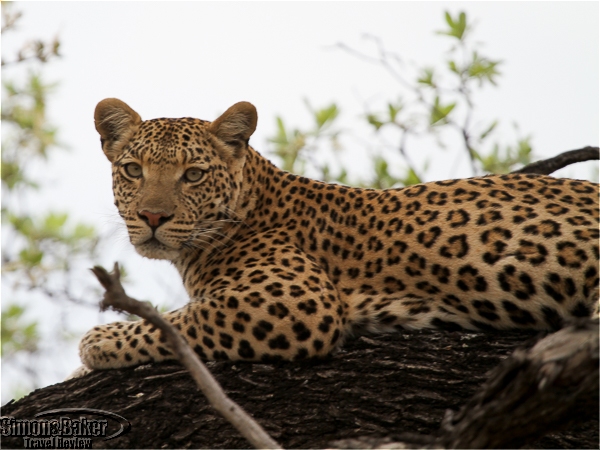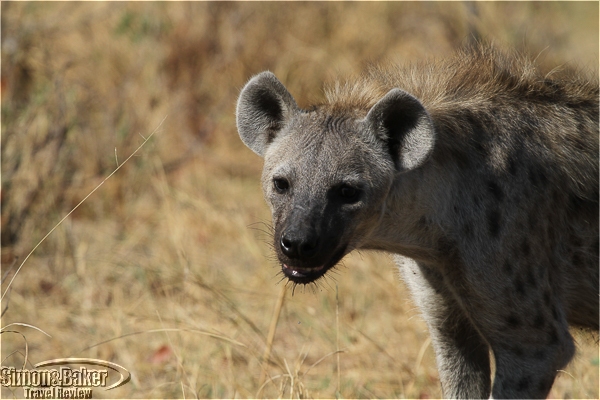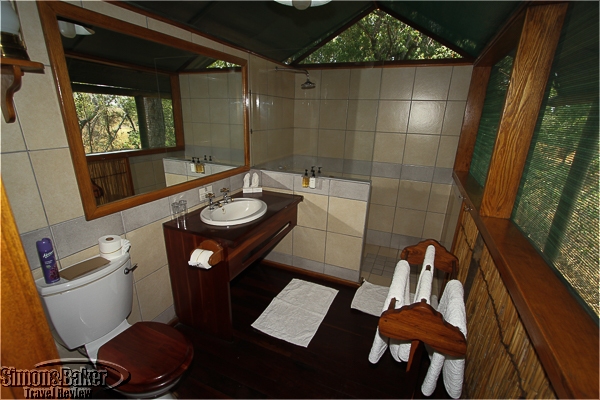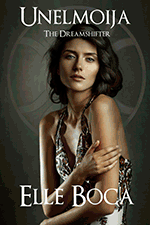
by Editor | Apr 25, 2016 | Accomodations, Attractions, Ecotourism, New Articles
By Elena del Valle
Photos by Gary Cox

A leopard in a tree near Camp Moremi
On our most recent safari trip to Southern Africa we stayed at six Desert & Delta Safari properties, five in Botswana and one in the Caprivi Strip of Namibia. Traveling to properties within the same company offered advantages. The management similarities provided us an idea of what to expect before arriving at each subsequent property. For example, they all had eco-friendly policies; offered us moist refresher towels on arrival and when we returned from game drives as well as welcome back staff greetings when we returned from our activities; with only one exception, they all served buffet meals of similar styles at shared communal tables; the camps that depended on generators for electricity had battery operated lights for times when the generators were off at night; and most were run by a four-person management team, many of whom were friendly and helpful when asked.

Our pilot bids us farewell after our arrival at Leroo La Tau from Maun to start the adventure

Safari Air had several comfortable Caravan aircraft
Another advantage of traveling to Desert & Delta Safaris properties was their shared charter air service. Since Chobe Holdings Limited owned Desert & Delta Safaris and Safari Air (Desert & Delta Safaris, Private bag 310, Maun, Botswana, +267 6861243, http://www.desertdelta.com, info@desertdelta.com), a non scheduled charter safari airline founded in 1992 and based out of Maun, they coordinated our transfers between the Desert & Delta Safaris properties and between our international arrival and departure airports. The company owned five GA8 Airvan, three Cessna Caravan and one Quest Kodiak. We appreciated the convenience of the well organized and on time service.

The heat drove many poolside in the afternoons
Our stay was hampered in part by a regional heat wave that stretched all the way to South Africa. Four of the six properties ran on generators. Because the rooms remained sealed most of the day they became over hot around the clock. More than once we or our fellow travelers became ill from the heat and dehydration. Thankfully, the game viewing vehicles had partial shade. In addition, wet face cloths and pool dips were helpful in reducing our body temperature.

The wildlife was centered around the Boteti River banks near Leroo LaTau
Leroo LaTau, on the edge of the Makgadikgadi National Park, was our favorite for game viewing and views of the Boteti River from our rooms and the common areas. This was in part because Slade, our guide, was one of the most passionate and engaged of the guides we spent time with on that three country multi week itinerary. We enjoyed seeing a bit of the regional zebra migration and predators such as lions and wild dogs as well as brilliant sunsets over the shallow waters of the river.

Sunset over the Okavango Delta

Time for a drink before dinner at Xugana Island Lodge
In Camp Moremi (see Tented camp offered good game viewing, creature comforts on edge of Okavango Delta) we liked the expansive views from the elevated deck. At Xugana Island Lodge, we delighted in the birding within the island, the sense of remoteness within the famous Okavango Delta, and pretty water setting as well as many boat outings and occasional hippo sightings. Savute Safari Lodge had the prettiest rooms and some of the tastiest and most abundant meals. We especially liked the views of the man made waterholes from the dining area and our tented rooms.

Breakfast at the Chobe Game Lodge with a view of the Chobe River
At the Chobe Savanna Lodge and Chobe Game Lodge, situated on opposite sides of the Chobe River and in separate countries, we were thankful for the air conditioned rooms. Although the border crossing from Botswana to Chobe Savanna Lodge on the Namibia side of the Chobe River was time consuming, hot and tedious we enjoyed the shady leisurely river rides on the pontoon boat. We particularly liked it when our boat was one of few on the river and we were alone with our local guide. The flat river water and quiet when the motor was off were particularly appealing. At the Chobe Game Lodge, we appreciated the three daily game viewing activities, and luxury amenities such as plated meals at private tables, in-room phones, WiFi internet access, work out room, spa room and its innovative electric safari vehicle.

A hyena in the Chobe Game Reserve

Elephants sharing a waterhole near Savute Safari Lodge in Chobe
Overall we had a fun trip and numerous bird and wildlife sightings of common species such as zebra, wildebeest, giraffe, impala, red lechwe (at Xugana), including elephant, buffalo, leopard and lion from the coveted Big Five. We saw beautiful birds, including the elusive paradise flycatchers, fish eagles multiple times, and particularly remember pairs of fish eagles relatively close to our boat at the Chobe Savanna Lodge. During the trip, we had extraordinary sightings such as wild dogs at Leroo La tau, crocodiles hunting, interactions between lions and elephants and numerous striking landscape and waterscape moments that will linger in our memories for years to come, and draw us back to Botswana and Africa in the future.

by Editor | Apr 11, 2016 | Accomodations, Ecotourism
By Elena del Valle
Photos by Gary Cox

Camp Moremi, a luxury tented camp in Botswana, Southern Africa

Our greeting committee was a coalition of lions.
During a recent multi-country safari itinerary we spent three nights at Camp Moremi (Desert & Delta Safaris, Private bag 310, Maun, Botswana, +267 6861243 and +267 6861418, Fax +267 6861791, http://www.desertdelta.com, camp.moremi@dds.co.bw), a luxury tented camp within Botswana’s Chobe Game Reserve in Southern Africa. To reach the property we flew on a small plane from Lerro LaTau, its sister Desert & Delta Safaris property on the Boteti River adjacent to the Makgadikgadi Pans. Our first impression driving from the landing strip through a mopane forest was of the vegetation and color contrast from the dry straw colored patches and scrawny plants of the Kalahari area to the south and the bushier greener area near camp.

A wildebeest watched us briefly before running off into the bush

A wattled crane
Arriving at the camp’s central lawn we heard the cacophony cries of dozens of Burchell’s starlings calling in the midday heat in the tree canopy above us. The game viewing property overlooked the Xakanaka Lagoon to the west and the inland mopane forest and open grasslands to the east. During our twice daily game drives in the reserve on partly open vehicles we saw three of the Big Five and many birds, as well as a number of other fauna. Our guide also identified some flora. Since visits to the park were limited to daytime hours, in the mornings, we entered the park immediately after sunrise and in the afternoons we exited right before sunset. At night, we had to be escorted by a staff member from our tents to dinner and back in case we encountered animals within the camp.

Our breakfast included a cold buffet.
Camp Moremi was established in 1984 and completely renovated in 2012. It had 12 luxury tents on a five hectare generator powered camp with 32 Setswana staff. Bruce Petty was the general manager. While we were there Thuso, Frank, Lydia, and Lettie shared management duties. The property, which had Ecotourism status from the Botswana Tourism Organisation, received a TripAdvisor 2015 Certificate of Excellence.

Thuso, Frank, Lydia, and Lettie managed Camp Moremi
Our accommodations consisted of 5 meter by 5 meter tents atop wood platforms set slightly above the bush. Each of our tents had four distinct areas: a spacious entry foyer with a writing desk and mirror; a bathroom with a walk in shower with hot and cold running water, and a flush toilet; a bedroom; and a covered bush facing deck.

The entry sitting space with mirror, desk and chair.
At a previous Desert and Delta Safaris property the staff provided a metal container for each of us to fill up with bottled water from a common area cooler. This method was designed to cut back on the number of plastic bottles discarded. Because of the high temperatures (reaching 45 Celsius while we were there) the water in that container heated up soon after filling it up. Our ice buckets were replenished once a day in the morning, but the ice melted within minutes. Refilling our bottles also required queuing up at the single water cooler when everyone was preparing for departure and time was limited. The water chilled from the cooler became warm within minutes. Also, carrying the bottles from our rooms to refill them in the main building was inconvenient, especially during the rest period between activities when it was hot and uncomfortable everywhere and we sought water to lower our body temperature and became thirsty. Although we liked the conservation minded concept behind the refillable non thermos metallic bottles, in practice the idea did not work well at all.

At night, the staff spread mosquito netting around the two single beds set next to each.

The bathroom in the tent had a bush view.
Meals and game drives were included in the nightly rates. Tent amenities included: two cotton bathrobes, Charlotte Rhys Refillable toiletries (conditioning shampoo, shower gel and body lotion), two umbrellas, insect repellent, insect spray, flashlight, and shower caps. There was no soap (only shower gel). There was a dining area with a bar and a library corner that included a popular computer for guest use with a very slow (1 megabyte, 1-100 kilobytes per second) connection, a curio shop, an elevated viewing deck facing the lagoon, and an outdoor pool.

Our best leopard sighting in Botswana
During our summer visit, the 1.5 meter deep plunge pool deck was the most comfortable place in the property in the middle hours of the day between brunch and tea time. The pool area had eight cushioned lounge chairs with rolled up towels on every chair and two large umbrellas. The pool floor was slick, requiring care to avoid slipping. There was also a cooler with bottled beverages although it had no ice so the beverages were almost at ambient temperature.

The pool was the place to find relief from the blistering heat

Our guide Osman in front of our safari vehicle
Our very bumpy game drives were aboard a canvas topped Toyota Landcruiser with three rows that could accommodate two passengers in each of the front rows and three in the rear row. Osman, our Setswana guide, had three years of experience. In his company we saw Kalahari apple-leaf, baobab, jackal-berry, leadwood, marula, sausage trees, blue water lily flowers and papyrus as well as baboon, bushbuck, elephants, giraffe, hippopotamus, brown hyena, lechwe, leopard, lion, banded mongoose, Selous mongoose, vervet monkey, reedbuck, sitatunga, South African ground squirrel, tsessebe, waterbuck warthog, wildebeest, and zebra. We also saw Nile crocodile, Nile monitor and Okavango hinged terrapin. He pointed out hippo tracks and mole rat holes.

A mother lion and her cub

The entrance to our tents was lit at night.
Birds we saw or heard included: arrow-marked babbler, black-collared barbet, crested barbet, bateleur, Southern carmine bee-eater, swamp boubou, reed cormorant, wattled crane, African darter, fork-tailed drongo, white-faced duck, yellow-billed duck, cattle egret, great egret, little egret, slaty egret, African fish-eagle, go-away-bird, Egyptian goose, spur-winged goose, Southern ground-hornbill, grey heron, purple heron, squacco heron, red-billed hoopoe, African hoopoe, African grey hornbill, red-billed hornbill, glossy hornbill, pied kingfisher, woodland kingfisher, yellow-billed kite, blacksmith lapwing, crowned lapwing, Meyer’s parrot, Kittlitz’s plover, broad-billed roller, brown snake-eagle, red-billed spurfowl, Burchell’s starling, Cape glossy starling, black-winged stilt, African stonechat, saddle-billed stork, yellow-billed stork, barn swallow, water thick-knee, hammerkop, wattled crane and golden-tailed woodpecker.
































